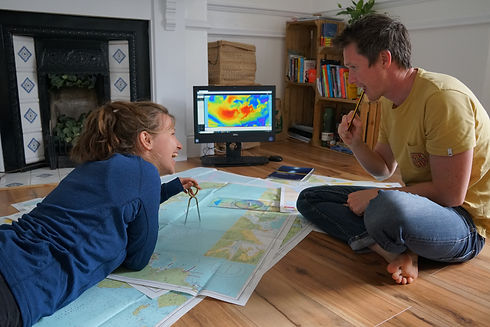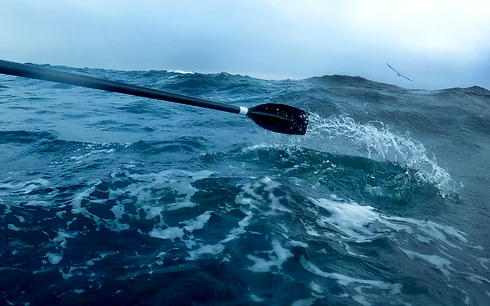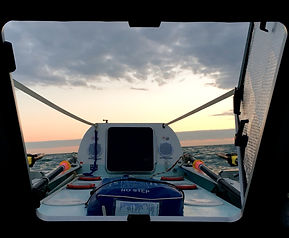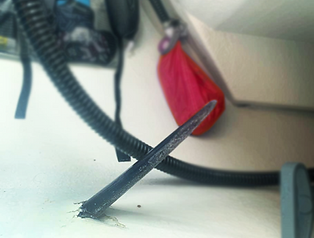
Whatever you
do, don't press this button.

Andy loves coffee
Andy loves coffee
8-12Litres of water each day to rhydrate ourselves and our rations
Water, water all around and not a drop to drink (“The Rime of the Ancient Mariner,” by Samuel Taylor Coleridge).

Andy loves coffee
WATER
Have you ever wondered how to rehydrate 480 ration packs? The answer comes from converting seawater using the desalination unit installed in the boat. It is powered by the solar panels onboard and capable of converting 30 litres of saltwater per hour.
This is our only means of fresh water and survival at sea. If it fails we will have to rely on the back up hand pump which is only capable of purifying less than 1 litre each hour and will have to be pumped in between rowing shifts.

They will be carrying all of their provisions on- board, battling sleep deprivation and physical exhaustion as they row in shifts to keep the boat moving 24 hours a day.
Home for the duration will be an ocean rowing boat measuring just 7 metres from bow to stern.
From the Canaries to the Caribbean, the pair will test the limits of their physical and mental endurance. Explore this website to find out more about the plans, preparations and the progress of an ocean row, and how to get involved!
3,000
Nautical Miles
2
Rowers
40 - 60
Days Alone At Sea
Atlantic Escapade is a project in which Andy Hodgson and Rosalind Chaston will attempt to row 3,000 nautical miles entirely unassisted across the Atlantic Ocean.
3,000 miles rowing completely unassisted

PREPARATION
Step One of rowing an ocean is a lot of planning. Along with essential time on the water and physical training, it's back to the classroom to study navigation, sea survival, and trauma first aid. On top of this, we will be working with a sports psychologist to prepare us for the sleep deprivation, mental exhaustion, and isolation that we'll face on the ocean.
We are studying weather forecasting, but will be in contact with our shore team via sat phone to keep us on the quickest and safest route.
The best time of year for a mid-Atlantic crossing is winter in the northern hemisphere, in order to avoid hurricanes and take advantage of trade winds. So the clock is ticking to get ready!
Burning 8,000 calories per day
FOOD
We must carry everything that we need to survive on board in order to qualify as an unassisted crossing. That includes enough food for the entire journey.
With no capacity for fresh food storage, freeze dried rations will be the staple of our diet. These are the best lightweight calories available and are lovingly prepared by dousing in hot water and leaving to rehydrate.
Despite aiming to consume 6,000-8,000 calories a day, the average weight loss for each rower is 10-12kg.
The ration packs will be supplemented with snacks and delicious treats to keep morale and calorie intake high. We will have to carry enough food for up to 70 days at sea. Rations alone will weigh over 150kg. This creates an extra incentive to eat - the more you eat, the faster you go.


8,000 calories a day is equivalent to
31 Big Macs,
53 bowls of cereal,
or 89 bananas!

Rowers can expect to lose 10 - 12kg during the crossing.

Consuming 10 litres of water per day

WATER
Have you ever wondered how to rehydrate 560 ration packs? The answer comes from converting seawater in to fresh drinking water using the desalination unit installed in the boat. It is powered by the solar panels onboard and capable of converting 30 litres of saltwater per hour.
This is our essential means of fresh water and survival at sea. If it fails we will have to rely on the back up hand pump which is only capable of purifying less than 1 litre every hour and will have to be pumped by very tired rowers in between rowing shifts.
"Water, water all around and not a drop to drink"
-The Rime of the Ancient Mariner
More people have climbed Everest than rowed the Atlantic Ocean
WEATHER
Setting off in the northern hemisphere winter months (after hurricane season has ended) gives us the best chance of a settled crossing but this is never guaranteed.
We'll face temperatures fluctuating between a blistering 40 degrees during the day to sub-zero at night. Rowing across the tropics will help maximise our daylight hours.
The easterly trade winds mean that, in theory, the winds are behind us. In practice though, this isn't always the case and many rowers get pushed north or south by low pressure storm systems. Winds can reach up to gale force, and sea swell, with no land to impede it, can build waves of up to 20 - 30ft.

The Atlantic Ocean covers 20% of the Earth's surface.


Atlantic rainfall can reach 2.4 trillion gallons a day.

With few distractions on the ocean, the plan is pretty simple: "eat, sleep, row, repeat". The challenge of rowing an ocean though, is never that straight forward.
We'll be alternating shifts on the oars to keep the boat moving 24 hours a day. When not rowing, we'll have a few hours to eat, sleep, and carry out essential maintenance on the boat. On the occasions when the wind and swell get too big to manage, we will use a parachute anchor to try and hold position and hunker down in the stern cabin to ride out the storm - a bumpy rest!
LIFE ON
BOARD
THE BOAT, BITS AND BOBS
Ocean rowing boats are an uncommon sight on the seas. They are typically a cramped 7 – 10 metres long with shared sleeping quarters the size of a 1 man tent. They are designed to self right if rolled over in big swell and watertight hatches along the hull provide storage areas for equipment and provisions. Packed with technology to allow the rowers to survive and navigate at sea, the boats can weigh up to a tonne at the start of an expedition.
(Hover over each button to find out more!)
Solar panels on the roof of each cabin convert sunlight to electricity which powers all of the boats onboard systems, from chart plotter and navigation equipment to the essential watermaker.
SOLAR PANELS
Large cargo ships could easily miss our tiny boat in big swell.
The target enhancer amplifies our radar reflection and alerts oncoming vessels of our position.
Nav lights will help make us visible in the dark, and the mirror allows us to see where we’re going.
RADAR REFLECTOR
This is our living quarters measuring 6x3ft - the same volume as a red telephone box and is our only shelter from storms. It also houses the electronic navigation equipment.
STERN CABIN
The Automatic Identification System (AIS) is mandated by the IMO for vessels larger than 300 tonnes. AIS transceivers automatically broadcast vessel information and GPS position data, preventing collisions between us and 300 tonne vessels!
AIS
The majority of provision storage and ballast is held in the hull of the boat, accessed through water tight hatches in the deck.
HULL STORAGE
Salt water is drawn up from below the boat and converted to safe drinking water. This is the only source of drinking water onboard.
DESALINATION
UNIT
This broadcasts the boat's position 24 hours a day. You can follow along with our progress through our website.
WARNING: Dot watching is addictive!
TRACKING UNIT

The boat is equipped with a VHF radio to communicate with other shipping and help avoid collisions. We'll also carry a satellite phone onboard to communicate with the shore team.
COMMS
Emergency position-indicating radio beacon transmits a signal to a satellite system and is used to alert search and rescue services in the event of an emergency.
EPIRB
The electronic navigation equipment and GPS allows us to plot our position and navigate the most efficient route across the ocean, as well as steering a course to avoid dangerous weather systems. Paper charts provide the failsafe backup.
CHART PLOTTER

Unless you have several miles of rope, there is nowhere to anchor in the mid-Atlantic. The parachute anchor is streamed from the bow of the boat to keep us nose in to heavy seas and limit drift in the wrong direction.
PARACHUTE ANCHOR
Ocean grade self-inflating life raft used if we have to abandon the boat. The life raft is equipped with survival provisions for up to 30 days.
LIFE
RAFT
This cabin houses essential systems including the watermaker, batteries, and ethanol generator.
BOW
CABIN
The Efoy fuel cell converts ethanol to electricity and tops up the batteries on cloudy days or when running the boat at night.
ETHANOL FUEL CELL



THE FIRST WEEK
The first week on board is always the toughest. Once the initial excitement has worn off, sea sickness and fatigue set in.
By about day 3, you start to question what you've let yourself in for - that's where the training comes in, setting up a familiar routine. From that point on, every oar stroke is a step closer to the finish line.
HOME FROM HOME
There are not many creature comforts available on board, and everything has to justify its weight.
This means that most items are dual-purpose. The bucket for example is essential for bailing out flooded compartments but also doubles as the only WC onboard and an ensuite with a view...
DANGERS
The obvious danger is big swell causing the boat to capsize. We are always attached to the boat via safety lines when on deck.
A less obvious, but very real, danger is a Marlin strike. Boats have increasingly been subject to strikes by these billfish who can penetrate the hull at speeds up to 60mph.


